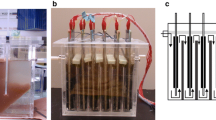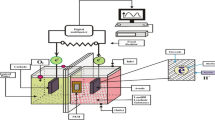Abstract
Effective wastewater treatment using microbial fuel cells (MFCs) will require a better understanding of how operational parameters and solution chemistry affect treatment efficiency, but few studies have examined power generation using actual wastewaters. The efficiency of wastewater treatment of a beer brewery wastewater was examined here in terms of maximum power densities, Coulombic efficiencies (CEs), and chemical oxygen demand (COD) removal as a function of temperature and wastewater strength. Decreasing the temperature from 30°C to 20°C reduced the maximum power density from 205 mW/m2 (5.1 W/m3, 0.76 A/m2; 30°C) to 170 mW/m2 (20°C). COD removals (R COD) and CEs decreased only slightly with temperature. The buffering capacity strongly affected reactor performance. The addition of a 50-mM phosphate buffer increased power output by 136% to 438 mW/m2, and 200 mM buffer increased power by 158% to 528 mW/m2. In the absence of salts (NaCl), maximum power output varied linearly with wastewater strength (84 to 2,240 mg COD/L) from 29 to 205 mW/m2. When NaCl was added to increase conductivity, power output followed a Monod-like relationship with wastewater strength. The maximum power (P max) increased in proportion to the solution conductivity, but the half-saturation constant was relatively unaffected and showed no correlation to solution conductivity. These results show that brewery wastewater can be effectively treated using MFCs, but that achievable power densities will depend on wastewater strength, solution conductivity, and buffering capacity.






Similar content being viewed by others
References
American Public Health Association, American Water Works Association, Water Pollution Control Federation (1998) Standard methods for the examination of water and wastewater, 20th edn. American Public Health Association, Washington DC
Bond DR, Lovley DR (2003) Electricity production by Geobacter sulfurreducens attached to electrodes. Appl Environ Microb 69(3):1548–1555
Cheng S, Logan BE (2007) Ammonia treatment of carbon cloth anodes to enhance power generation of microbial fuel cells. Electrochem Commun 9(3):492–496
Cheng S, Liu H, Logan BE (2006a) Increased performance of single chamber microbial fuel cells using an improved cathode structure. Electrochem Commun 8(3):489–494
Cheng S, Liu H, Logan BE (2006b) Power densities using different cathode catalysts (Pt and CoTMPP) and polymer binders (Nafion and PTFE) in single chamber microbial fuel cells. Environ Sci Technol 40(1):364–369
Fan Y, Hu H, Liu H (2007) Enhanced coulombic efficiency and power density of air-cathode microbial fuel cells with an improved cell configuration. J Power Sources 171(2):348–354
Gil GC, Chang IS, Kim BH, Kim M, Jang JK, Park HS, Kim HJ (2003) Operational parameters affecting the performance of a mediator-less microbial fuel cell. Biosens Bioelectron 18(4):327–334
Guo W (2005) Compulsory discharge standard of pollutants for beer industry is to be published. China Environment Daily: 2005-12-6
He Z, Wagner N, Minteer SD, Angenent LT (2006) An upflow microbial fuel cell with an internal resistance by impedance spectroscopy. Environ Sci Technol 40:5212–5217
Heilmann J, Logan BE (2006) Production of electricity from proteins using a single chamber microbial fuel cell. Water Environ Res 78(5):531–537
Ince BK, Ince O, Sallis PJ, Anderson GK (2000) Inert COD production in a membrane anaerobic reactor treating brewery wastewater. Water Res 34(16):3943–3948
Kida K, Tanemura K, Sonoda Y, Hikami S (1994) Anaerobic treatment of distillery waste-water from barley-shochu making by UASB. J Ferment Bioeng 77(1):90–93
Kim BH, Park HS, Kim HJ, Kim GT, Chang IS, Lee J, Phung NT (2004) Enrichment of microbial community generating electricity using a fuel cell type electrochemical cell. Appl Microbiol Biotechnol 63(6):672–681
Kim JR, Jung SH, Regan JM, Logan BE (2007) Electricity generation and microbial community analysis of alcohol powered microbial fuel cells. Bioresour Technol 98(13):2568–2577
Liu H, Logan BE (2004) Electricity generation using an air-cathode single chamber microbial fuel cell in the presence and absence of a proton exchange membrane. Environ Sci Technol 38(14):4040–4046
Liu H, Ramnarayanan R, Logan BE (2004) Production of electricity during wastewater treatment using a single chamber microbial fuel cell. Environ Sci Technol 38(7):2281–2285
Liu H, Cheng S, Logan BE (2005a) Power generation in fed-batch microbial fuel cells as a function of ionic strength, temperature, and reactor configuration. Environ Sci Technol 39(14):5488–5493
Liu H, Cheng S, Logan BE (2005b) Production of electricity from acetate or butyrate in a single chamber microbial fuel cell. Environ Sci Technol 39(2):658–662
Logan BE, Murano C, Scott K, Gray ND, Head IM (2005) Electricity generation from cysteine in a microbial fuel cell. Water Res 39(5):942–952
Logan BE, Hamelers B, Rozendal R, Schröder U, Keller J, Freguia S, Aelterman P, Verstraete W, Rabaey K (2006) Microbial fuel cells: methodology and technology. Environ Sci Technol 40(17):5181–5192
Min B, Kim JR, Oh SE, Regan JM, Logan BE (2005) Electricity generation from swine wastewater using microbial fuel cells. Water Res 39(20):4961–4968
Oh S, Logan BE (2005) Hydrogen and electricity production from a food processing wastewater using fermentation and microbial fuel cell technologies. Water Res 39(19):4673–4682
Parawira W, Kudita I, Nyandoroh MG, Zvauya R (2005) A study of industrial anaerobic treatment of opaque beer brewery wastewater in a tropical climate using a full-scale UASB reactor seeded with activated sludge. Process Biochem 40(2):593–599
Pham TH, Rabaey K, Aelterman P, Clauwaert P, De Schamphelaire L, Boon N, Verstraete W (2006) Microbial fuel cells in relation to conventional anaerobic digestion technology. Eng Life Sci 6(3):285–292
Rabaey K, Lissens G, Siciliano SD, Verstraete W (2003) A microbial fuel cell capable of converting glucose to electricity at high rate and efficiency. Biotechnol Lett 25:1531–1535
Rabaey K, Ossieur W, Verhaege M, Verstraete W (2005a) Continuous microbial fuel cells convert carbohydrates to electricity. Water Sci Technol 52(1–2):515–523
Rabaey K, Clauwaert P, Aelterman P, Verstraete W (2005b) Tubular microbial fuel cells for efficient electricity generation. Environ Sci Technol 39(20):8077–8082
Speece RE (1996) Anaerobic biotechnology for industrial wastewater. Archae, Nashville, TN
Vijayaraghavan K, Ahmad D, Lesa R (2006) Electrolytic treatment of beer brewery wastewater. Ind Eng Chem Res 45(20):6854–6859
Wang SG, Liu XW, Gong WX, Gao BY, Zhang DH, Yu HQ (2007) Aerobic granulation with brewery wastewater in a sequencing batch reactor. Bioresour Technol 98(11):2142–2147
Zhao F, Harnisch F, Schröder U, Scholz F, Bogdanoff P, Herrmann I (2005) Application of pyrolysed iron(II) phthalocyanine and CoTMPP based oxygen reduction catalysts as cathode materials in microbial fuel cells. Electrochem Commun 7(12):1405–1410
Zuo Y, Maness PC, Logan BE (2006) Electricity production from steam-exploded corn stover biomass. Energy Fuels 20(4):1716–1721
Zuo Y, Cheng S, Call D, Logan BE (2007) Tubular membrane cathodes for scalable power generation in microbial fuel cells. Environ Sci Technol 41(9):3347–3353
Acknowledgments
The research was supported by the National Science Foundation of China (Nos. 50578050 and 50638020). The authors thank Yanhui Qu for assistance with beer brewery wastewater collection. The research was also supported by the Program for Changjiang Scholars and Innovative Research Team in the University of China (IRT0424).
Author information
Authors and Affiliations
Corresponding author
Rights and permissions
About this article
Cite this article
Feng, Y., Wang, X., Logan, B.E. et al. Brewery wastewater treatment using air-cathode microbial fuel cells. Appl Microbiol Biotechnol 78, 873–880 (2008). https://doi.org/10.1007/s00253-008-1360-2
Received:
Revised:
Accepted:
Published:
Issue Date:
DOI: https://doi.org/10.1007/s00253-008-1360-2




